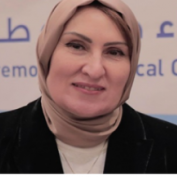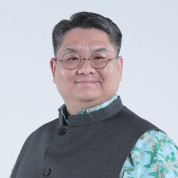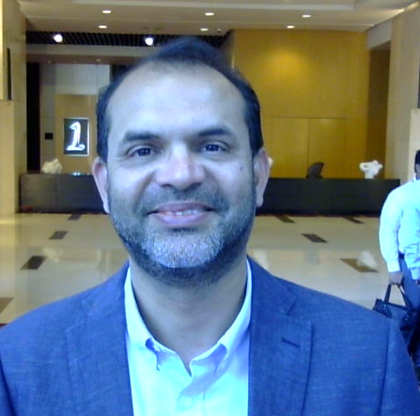Geopolitics, Arms Race, and Humanity
The world is facing a polycrisis with several challenging crises at the same time, wars and conflicts, climate change, environmental destruction, resulting in huge impact on people’s and the planet’s health. These crises are interlinked and therefore need common, synergistic solutions, involving both commercial, social and geopolitical determinants of health. The average level of global peace has been declining for eleven of the past fourteen years with huge implications for humanity. Two billion people, or a quarter of the world's population, live in conflict-affected areas, according to the UN, but there are many more impacted. “In 2022, fatalities from organized violence increased by a staggering 97%, compared to the previous year, making 2022 the deadliest year since the Rwandan genocide in 1994.”[1]

An estimated 89 million people are displaced due to conflict, violence and violations of human rights, and experience loss of family, physical and mental injuries, psychological trauma, and pushed towards the poverty line. Forced displacement often affects the most vulnerable who already severely disadvantaged.[2]
In 2022, 46.9 billion USD was spent to provide humanitarian assistance to over 406.6 million people.[3] 75-90% of the humanitarian burden is due to conflict and war, and political instability. At the same time, we have a race for more weapons. 2022 saw at least 600 billion USD weapons tradeand an incredible 2,240 billion USD total military expenditure 50 times the amount given in humanitarian aid.[4]
The World Bank identifies conflict countries and fragile states based on the number of conflict-related deaths per year in absolute numbers (>250) and in relation to their population (>2 per 100,000 inhabitants).[5] It uses two different data sources (The Armed Conflict Location & Event Data Project (ACLED) and The Uppsala Conflict Data Program (UCDP)), which in turn obtains information from health personnel, researchers, and authorities. For a country to be classified, both data sources must show that deaths are above the threshold value. Acute, short-term events are not considered towards classification. Over 20 countries are now classified as conflict countries.
Fragility is defined as “a systemic condition or situation characterized by an extremely low level of institutional and governance capacity which significantly impedes the state’s ability to function effectively, maintain peace and foster economic and social development”.5
The evolution of arms race
The concept of the arms race is used to describe a competitive and escalating accumulation of military weapons and technologies between rival nations or groups of nations. The classic model of the arms race was the naval sphere between Britain and Germany before World War I, with a competition in terms of both numbers and power of battleships (the so-called Dreadnoughts). The second classic arms race was the nuclear competition between the USA and the USSR during the period of Cold War (1947-1991).
Both sides engaged in a relentless arms production, particularly in the development of nuclear weapons, ballistic missiles, and strategic bombers. During the Cold War, the two superpowers also produced chemical and biological weapons in abundance.
In recent years, there has been a renewed focus on military modernization using emerging technologies which includes advancements in cyber warfare, autonomous weapons, hypersonic missiles, and space-based capabilities. Major powers are increasingly investing in research and development to maintain strategic superiority.
On the other side, there is a long record of efforts towards disarmament through Treaties. The record of success is mixed. There were numerous failures of arms embargoes imposed by the UN. The illicit arms trade, thrives in regions experiencing conflict or instability, continues to undermine disarmament efforts.
Several examples of failed efforts on disarmament demonstrate the complexities and challenges involved in achieving successful disarmament and preventing arms proliferation. They highlight the difficulties in ensuring compliance with international agreements, preventing the acquisition of weapons by non-state actors, and addressing the motivations and incentives for countries to engage in arms races.
Geopolitics, war, and its impact on health
Global health is strongly influenced by geopolitics and international relations. Health inequalities and inequities are driven by social determinants such as poverty, conflict, urbanization, industrialization which are impacted by geopolitical factors. To achieve better outcomes of global health policies, it is important to understand and address these factors. Geopolitical determinants are related to governments, geographies, policies, and the interests of countries and the relationship between them[6].
COVID-19 pandemic has shown how closely local or national health is linked to global health. However, often policy makers, especially in resource constrained countries, have either insufficient understanding of geopolitical determinants of health or are unable to address them adequately towards their advantage. While over the years, conceptual understanding of social determinants of health has grown, geopolitical determinants have not received enough attention by the health community. Good understanding of geopolitical aspects facilitates advocacy and action on achievement of health goals such as universal health coverage and health security.
War and conflict have a dramatic impact on health and development: violent injuries, disease outbreaks, increased malnutrition, psychological trauma, sexual and gender-based violence, as well as the destruction of health services and health systems. War and conflict affect the social determinants of health, such as education, income, living conditions, upbringing, work and death. Seven out of 10 countries, with the world's highest maternal mortality and infant mortality rates (according to the World Bank), are categorized as fragile and conflict-affected countries. A majority of cases of epidemic diseases (cholera, measles and meningitis) are recorded in conflict and fragile states.

Figure text: The impact of conflict on humanity.
In 2022, there were close to 2,000 attacks on health workers and health facilities, of which 232 health workers were killed, close to 300 were kidnapped and as many were arrested.[7] Doctors Without Borders and other organizations are often delayed in treating patients due to state and non-state armed groups.
Health, a basic human right, ought to be prioritized by governments by investing more in health and development than military expenditure and arms race. Advocates for prevention for war and promotion of peace through health have long advocated for reduction of expenditure on weapons and more on health.
Health for peace has long been argued as one of the potential interventions to promote and achieve peace in conflict affected settings. Health with its neutral status, as proponents highlight, can bridge opposite sides to promote dialogue, cooperate to serve humanity, and gradually encourage peaceful coexistence.[8] Experiences of health as bridge for peace in Latin America and in WHO Eastern Mediterranean Region have been documented. As peace becomes more elusive in increasing number of countries making delivery of health care difficult and increasing suffering of humanity, advocates of health for peace are calling for a renewed effort to use health platforms, mechanisms and opportunities to promote and sustain peace.[9] [10]
[1] Davies, S., Pettersson, T., & Öberg, M. (2023). Organized violence 1989–2022, and the return of conflict between states. Journal of Peace Research, 60(4), 691-708. https://doi.org/10.1177/00223433231185169
[2] Abubakar, I., Aldridge, R., Devakumar, D., et.al. (2018). The UCL–Lancet Commission on Migration and Health: the health of a world on the move. The Lancet Commissions, Vol.392:10164, p2606-2654. https://doi.org/10.1016/S0140-6736(18)32114-7
[3] Development Initiatives, 2023. Global Humanitarian Assistance Report 2023. Available at: https://devinit.org/resources/global-humanitarian-assistance-report-2023
[4] Xiao Liang, Lorenzo Scarazzato, Dr Lucie Béraud-Sudreau, Dr Nan Tian, Dr Diego Lopes da Silva, Yeoun Choi and Eero Kristjan Sild. SIPRI, Stockholm, Sweeden. December 2023. Available at: Trends in World Military Expenditure, 2022 | SIPRI
[5] World Bank, 2023. Classification of Fragility and Conflict Situations (FCS) for World Bank Group Engagement. Available at: https://thedocs.worldbank.org/en/doc/fb0f93e8e3375803bce211ab1218ef2a-0090082023/original/Classification-of-Fragility-and-Conflict-Situations-FY24.pdf
[6] Persaud, A., Bhugra, D., Valsraj, K. and Bhavsar, V., 2021. Understanding geopolitical determinants of health. Bulletin of the World Health Organization, 99(2), p.166.
[7] Ignoring Red Lines: Violence against health care in conflict. The Safeguarding Health in Conflict Coalition. Baltimore, USA, 2022. Available at: https://insecurityinsight.org/wp-content/uploads/2023/05/SHCC-Report-Ignoring-Red-Lines.pdf
[8] World Health Organization, 2023. Global Health and Peace Initiative (GHPI): Fifth Draft of the Roadmap. Available at: v5---ghpi-roadmap.pdf (who.int)
[9] The Lancet Commission on peaceful societies through health equity and gender equality, 2023. Available at: The Lancet Commission on peaceful societies through health equity and gender equality (thelancet.com)
[10] The Lancet Commission on Syria: Health in Conflict, 2017. Available at: Syria: Health in Conflict (thelancet.com)
Objectives of the session:
1. To better understand the impact of geopolitical determinants, including war and conflict, on health;
2. To analyze effectiveness and failures of strategies, policies and interventions, which minimize geopolitical tensions and the importance for health;
3. To discuss evidence and call for action on health as a bridge for peace in an era of polycrises.
4. To explore the relation of the arms industry and public institutions/governments; the use of legal determinants of health
PANELISTS
Biosketch
Ahmed Al-Mandhari
Dan Smith
Espen Bjertness
Ghada Al Jadba
Peter Friberg
Piti Srisangnam
Reza Majdzadeh
Wasiq Khan









